Bunraku is a traditional form of Japanese puppetry that is widely considered to be one of the most intricate and highly developed forms of puppetry in the world.
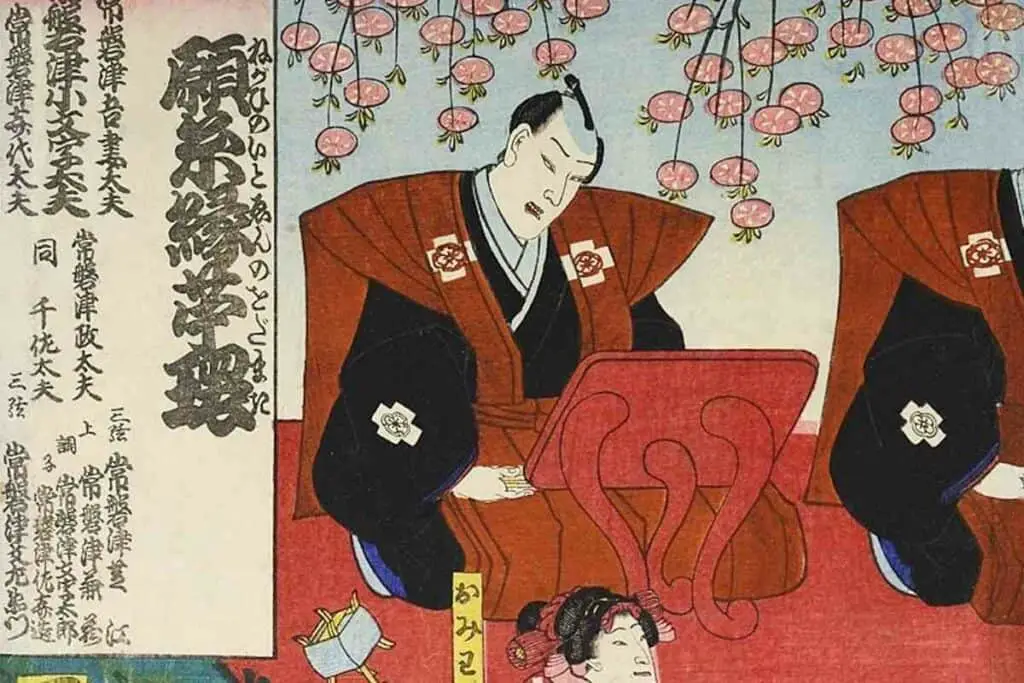
Despite its popularity, however, there are many people who are not familiar with the history or origins of this unique art form.
What to Expect? In this blog post, we will explore the history of Bunraku and examine how it has evolved over the years. We will also take a closer look at some of the key players in Bunraku history, including puppet masters and playwrights.
So read on for an in-depth look at this fascinating art form.
Table of Contents
The Bunraku History Explained
In Japan, Bunraku is a traditional form of theater that has been around for centuries. It is performed by three puppeteers who control each individual character in the play.
These puppeteers are referred to as “bunraku-jō” and they wear black robes with white masks which represent the characters they’re manipulating on stage.
Let’s take a closer look at the history of Bunraku.
What Is It?
Bunraku is a form of Japanese puppetry that was developed in the early 17th century.
It is typically performed with three puppeteers operating each puppet, which can range in size from just a few inches to over six feet tall.
The puppeteers dress in black and wear hoods to conceal their identities, which adds to the illusion that the puppets are alive.
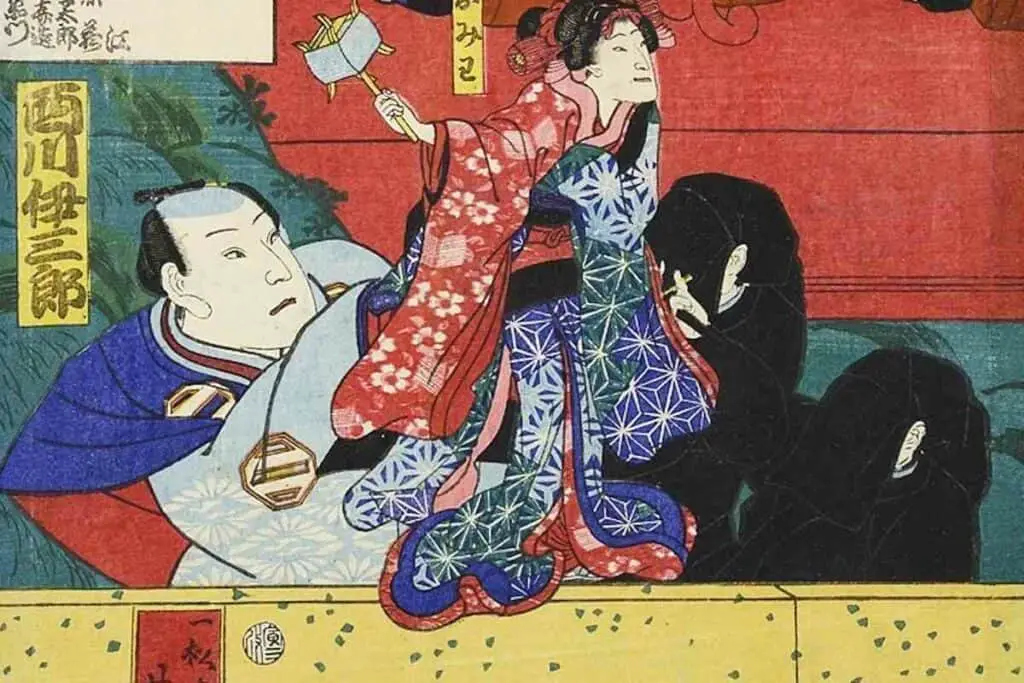
The puppeteers also use their voices to provide all of the dialogue for the puppet characters.
The word “Bunraku” is actually derived from two Chinese characters that mean “supporting rollers.” This refers to the wooden rods that are used to support and operate the larger puppets.
Bunraku puppets are usually made out of wood, but they can also be made out of other materials like paper or cloth.
The heads of the puppets are often very intricate and detailed, with realistic features such as wigs, mustaches, and beards.
Also Read ?
Bunraku plays are typically based on historical events or stories from Japanese folklore. The plays are usually quite long, often lasting several hours.
They are also very slow-paced, with each scene being meticulously rehearsed and choreographed beforehand.
Keep In Mind – This gives Bunraku a reputation for being a very slow and dull form of entertainment, but many people who have seen it performed live say that it is actually quite fascinating to watch.
The Origin
The origins of Bunraku date back to the early 1600s, when the first professional puppet theater was established in Osaka.
This new form of puppetry quickly became popular with the city’s residents, and it wasn’t long before other cities across Japan began to establish their own puppet theaters.
The most famous of these early puppet theaters was the Takarazuka Bunraku Theater, which was founded in 1784.
The Takarazuka Theater was known for its lavish and highly stylized productions, which often featured beautiful female puppets that were operated by hidden puppeteers.
The theater’s popularity soon spread beyond Osaka, and it eventually became one of the most popular tourist attractions in all of Japan.
In the early 1900s, Bunraku began to decline in popularity, due in part to the rise of cinema and television.
However, the art form has experienced a resurgence in recent years, thanks in part to the efforts of contemporary puppet masters who are keeping the tradition alive.
Today: There are several professional Bunraku theaters in Japan, and the art form is also gaining popularity overseas.
What Are Bunraku Plays About?
Bunraku plays are often about stories of love, loss, and revenge.
Many of the most popular Bunraku plays are based on historical events or Japanese folklore. There are also many comedies and tragedies written specifically for the Bunraku stage.
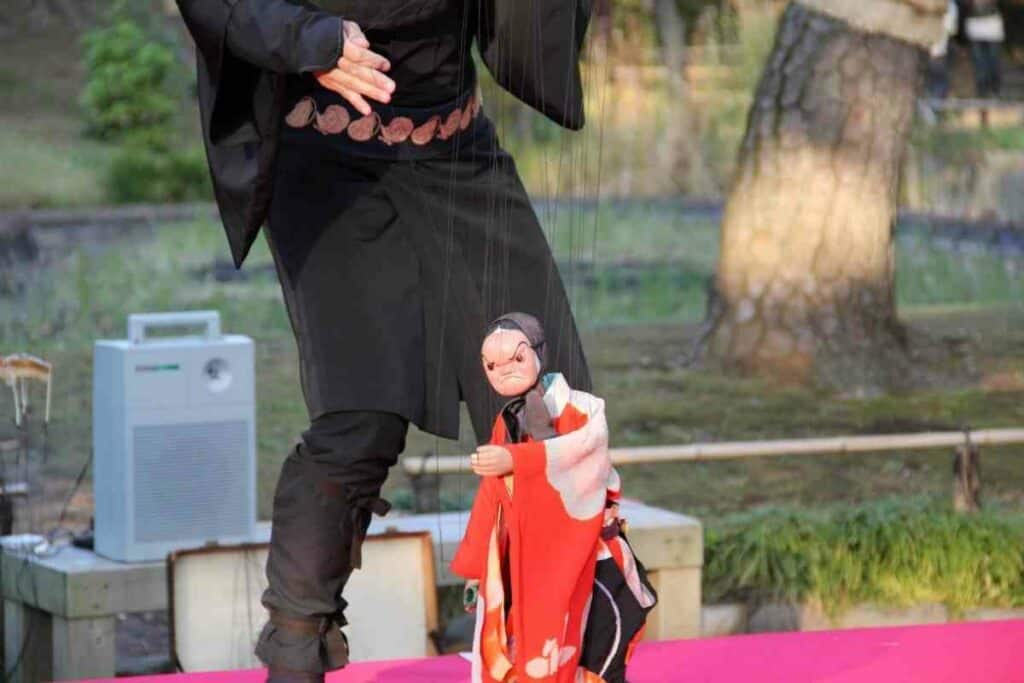
One of the most famous Bunraku plays is “The Tale of the Heike,” which tells the story of the Genpei War of 1180-1185.
This play has been performed countless times over the centuries and is still popular today.
Other well-known Bunraku plays include “The Battles of Coxinga” and “The Love Suicides at Sonezaki.”
What Do Bunraku Puppets Look Like?
Bunraku puppets are traditionally crafted from wood, with a carved head and hands.
The body is then covered with cloth or other materials, and the puppet is dressed in elaborate costumes.
The face of the puppet is often painted to resemble a human face, and the eyes may be made of glass or other materials to create a lifelike appearance.
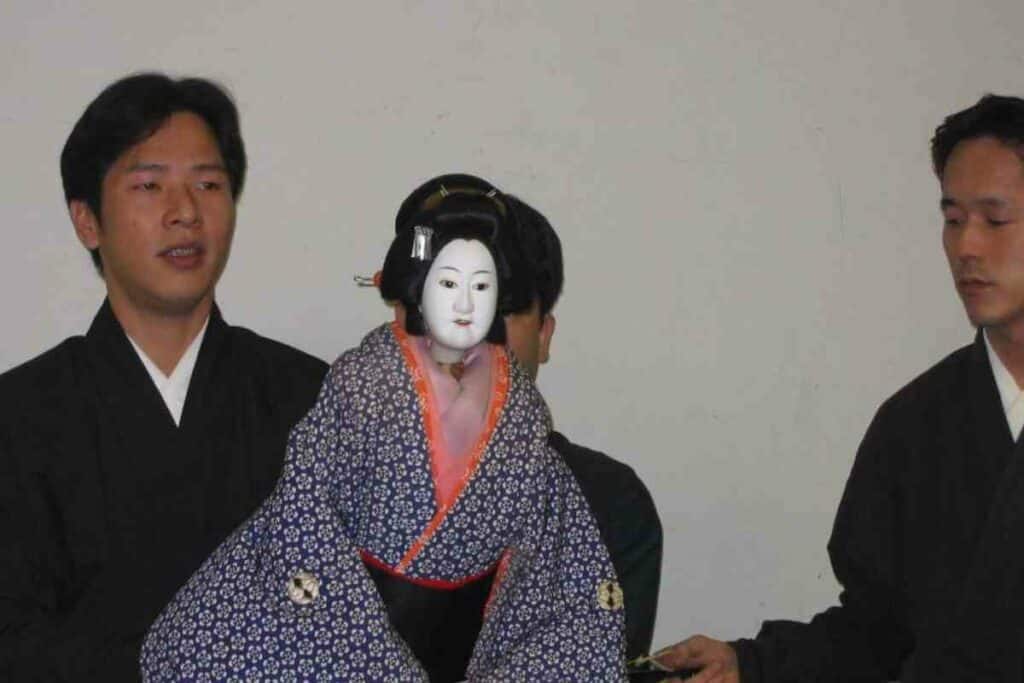
The puppeteers who operate the Bunraku puppets are also dressed in traditional Japanese clothing, and they often wear masks to conceal their identity.
The puppeteers use a variety of techniques to control the puppet, including using strings or rods attached to the puppet’s body or manipulating the puppet’s limbs directly.
How does it Work?
The ningyotsukai (puppeteers), tayu (chanter), and shamisen player are the three types of bunraku actors. The puppeteers perform on the main stage (hombutai). Also, you can expect the tayu and musician sit on a partition off to the side.
During a performance, the tayu will chant the story, describing the actions of the puppets.
The shamisen player will provide music to set the mood and also help guide the tempo of the show.
The ningyotsukai use two types of puppets:
- kodomo ningyo (child puppets)
- orokemono ningyo (adult puppets)
The kodomo ningyo are about 30 cm (1 ft) tall and are easier to control.
They are used for scenes that require a lot of movement, such as fights or dances.
Orokemono ningyo is larger, about twice the size of the kodomo ningyo. They are used for scenes that require less movement, such as conversations.
Each ningyotsukai controls one puppet at a time.
The left-hand controls the head and the right-hand controls the right arm.
Sometimes both hands are needed to control the arms, especially when the puppet is doing something like writing.
The ningyotsukai’s feet are used to control the puppet’s legs.
The ningyotsukai also wear special tabi socks with wooden clogs (geta) so they can move around the stage without making any noise.
This is important because the audience should only be able to hear the tayu and shamisen players.
What Are Famous Bunraku Plays?
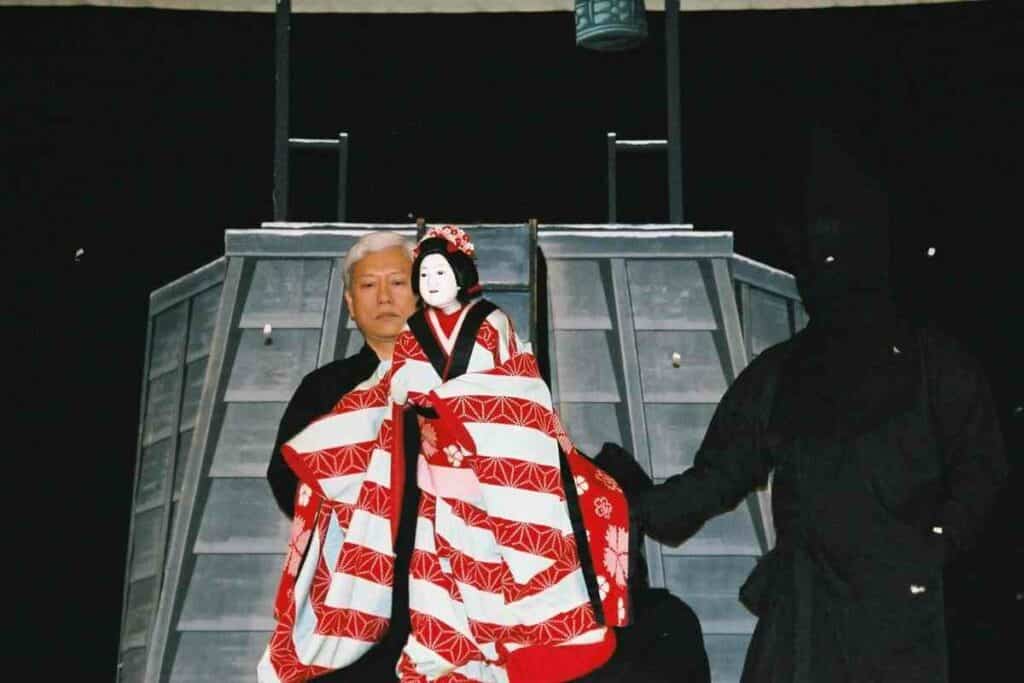
Kanadehon Chushingura
It was first performed in 1748 at the Takemotoza theater in Osaka, and Kanadehon Chushingura (roughly translated as Chushingura: The Treasury of Loyal Retainers) is one of the most famous pieces of bunraku drama.
It tells the story of the 47 ronin, a group of masterless samurai who avenged their lord’s death by slaying the man who had forced him to commit seppuku (ritual suicide).
The play is notable for its use of puppets that are about half the size of a human, which allows for very precise and detailed movements.
It is also known for its lengthy running time – Kanadehon Chushingura can easily last for over four hours.
Love Suicides at Sonezaki
The Chikamatsu Monzaemon classic Love Suicides at Sonezaki, which Bunraku adapted from a 1629 play, is a masterpiece of dramatic storytelling and love-struck tragedy.
The tale was based on a real love suicide that occurred only a month prior to Monzaemon’s recreation of the narrative.
In the play, a young couple in love, Tokubei, and Ohatsu, plan to elope but are intercepted by Ohatsu’s arranged marriage.
Faced with the prospect of a life apart, the lovers agree to die together instead.
The story is told through the eyes of Shinzaemon, Tokubei’s best friend who tries unsuccessfully to stop the lovers from carrying out their plan.
The Battles of Coxinga
Another Chikamatsu Monzaemon classic is The Battles of Coxinga (1715), better known as The Battles of Kokusen.
It was perhaps his most renowned play, running for a record 17 months in Osaka after its premiere in November that year.
It is also the only one of his plays to have been adapted for kabuki, in 1741.
In This Work – Coxinga (Kokusenya) is a young Chinese warlord intent on wresting control of China from the ruling Ming Dynasty.
Where to Watch Bunraku?
During the Second World War, bunraku was again on hiatus, only resuming a year after the conflict’s end.
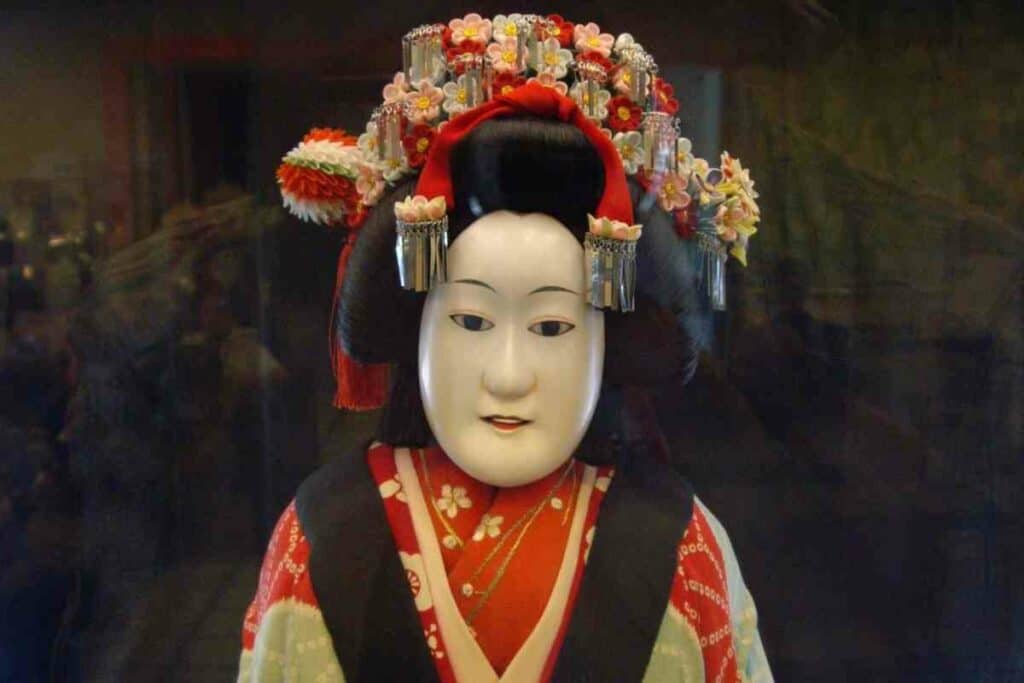
By the end of the 20th century, two major bunraku theaters had opened in Osaka and Tokyo, kick-starting today’s revival.
Tokyo
The National Theatre in Tokyo is home to the world’s largest and most active bunraku troupe, the Ichikawa Danjūrō Company.
It stages several full-length productions each year, as well as shorter programs of excerpts. The company also travels internationally on a regular basis.
Osaka
The Bunraku Bayashi-za is Osaka’s primary bunraku theater.
It was founded in 1984 by the legendary Ichikawa Danjūrō VIII and his son Danjūrō IX, who also served as its first director.
The company stages several productions each year, ranging from full-length plays to excerpted programs.
Why Is Bunraku Important to Japanese Culture?
It is a UNESCO Intangible Cultural Heritage in addition to noh and kabuki.
Bunraku, which literally means “the art of puppetry,” is a form of traditional Japanese theater that dates back to the early Edo period.
The three-stringed shamisen accompanies the puppeteers who control the figures with their hands and voices.
The most important aspect of bunraku is its ability to tell a story and evoke emotions in the audience.
The puppets are incredibly lifelike, and the skilled performers are able to bring them to life in a way that is both realistic and deeply moving.
Bunraku is important to Japanese culture because it is a living embodiment of traditional values and aesthetics.
It is an art form that is deeply rooted in the country’s history and continues to be enjoyed by generations of Japanese people.
Why Is Bunraku Unique?
It is the most lifelike, most realistic type of puppetry in the world.
The level of detail and craftsmanship that goes into making Bunraku puppets is incredible.
The bodies are made from wood, and the faces are carved from ivory. They are then painted by hand to look as realistic as possible.
The level of detail extends to the clothes that the puppets wear.
Bunraku puppeteers take great care to make sure that the clothes are accurate representations of clothing from the period that the play is set in.
Conclusion
The Bunraku puppet show is a form of traditional Japanese theatre that has been around for centuries.
It combines puppetry, music, and dance to create an unforgettable experience.
While the history of bunraku is fascinating in its own right, there are several reasons why this unique art form should be experienced by everyone.
Read Next
- 12 Things Tourists Should NEVER Say in Japan
- Kissing Robot: Exploring the Popularity of the Chinese Kissing App
- Unlocking the Secret Dating Rituals Only Locals Know in Japan
- Samurai Armor: Ancient Protection for Japan’s Elite Warriors
- 10 Amazing Facts About Schools in Japan: Unique Traditions and Educational Practices
- Where can you see snow monkeys in Japan: Best locations and viewing tips









